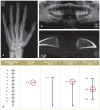Forensic Age Estimation
- PMID: 26883413
- PMCID: PMC4760148
- DOI: 10.3238/arztebl.2016.0044
Forensic Age Estimation
Abstract
Background: Forensic age estimation is requested by courts and other government authorities so that immigrants whose real age is unknown should not suffer unfair disadvantages because of their supposed age, and so that all legal procedures to which an individual's age is relevant can be properly followed. 157 age estimations were requested in Berlin in 2014, more than twice as many as in 2004.
Methods: This review is based on pertinent articles retrieved by a selective search in the PubMed and MEDPILOT databases, supplemented by relevant recommendations and by the findings of the authors' own research.
Results: The essential components of age estimation are the history, physical examination, X-rays of the hands, panorama films of the jaws, and, if indicated, a thin-slice CT of the medial clavicular epiphyses, provided that there is a legal basis for X-ray examinations without a medical indication. Multiple methods are always used in combination, for optimal accuracy. Depending on the legal issues at hand, the examiner may be asked to estimate the individual's minimum age and/or his or her most probable age. The minimum-age concept can be used in determinations whether an individual has reached the age of legal majority. It is designed to ensure that practically all persons classified as adults have, in fact, attained legal majority, even though some other persons will be incorrectly classified as minors.
Conclusion: Forensic age estimation lets courts and other government authorities determine the official age of persons whose actual age is unknown-in most cases, unaccompanied refugees who may be minors. The goal is to carry out age-dependent legal procedures appropriately in accordance with the rule of law. The minimum-age concept is designed to prevent the erroneous classification of minors as legal adults.
Figures





Comment in
-
No Medical Indication.Dtsch Arztebl Int. 2016 Jul 11;113(27-28):486. doi: 10.3238/arztebl.2016.0486a. Dtsch Arztebl Int. 2016. PMID: 27476711 Free PMC article. No abstract available.
-
Minimum Age Concept: Full of Pitfalls.Dtsch Arztebl Int. 2016 Jul 11;113(27-28):486-7. doi: 10.3238/arztebl.2016.0486b. Dtsch Arztebl Int. 2016. PMID: 27476712 Free PMC article. No abstract available.
-
One-sided Overview of the Problem.Dtsch Arztebl Int. 2016 Jul 11;113(27-28):487. doi: 10.3238/arztebl.2016.0487a. Dtsch Arztebl Int. 2016. PMID: 27476713 Free PMC article. No abstract available.
-
Exceedingly Rare.Dtsch Arztebl Int. 2016 Jul 11;113(27-28):487. doi: 10.3238/arztebl.2016.0487b. Dtsch Arztebl Int. 2016. PMID: 27476714 Free PMC article. No abstract available.
-
In Reply.Dtsch Arztebl Int. 2016 Jul 11;113(27-28):488. doi: 10.3238/arztebl.2016.0488. Dtsch Arztebl Int. 2016. PMID: 27476715 Free PMC article. No abstract available.
Similar articles
-
The role of forensic medicine and forensic dentistry in estimating the chronological age of living individuals in Hamburg, Germany.Int J Legal Med. 2017 Mar;131(2):593-601. doi: 10.1007/s00414-016-1517-y. Epub 2016 Dec 28. Int J Legal Med. 2017. PMID: 28032243
-
Forensic age assessment of living adolescents and young adults at the Institute of Legal Medicine, Münster, from 2009 to 2018.Int J Legal Med. 2020 Mar;134(2):745-751. doi: 10.1007/s00414-019-02239-2. Epub 2020 Jan 2. Int J Legal Med. 2020. PMID: 31907616
-
[History, present situation and perspectives of forensic age diagnostics of living persons].Arch Kriminol. 2013 May-Jun;231(5-6):145-55. Arch Kriminol. 2013. PMID: 23878893 Review. German.
-
[Forensic age determination in living individuals at the Institute of Legal Medicine in Berlin (Charité): analysis of the expert reports from 2001 to 2007].Arch Kriminol. 2009 Nov-Dec;224(5-6):168-76. Arch Kriminol. 2009. PMID: 20069774 German.
-
Age estimation: the state of the art in relation to the specific demands of forensic practise.Int J Legal Med. 2000;113(3):129-36. doi: 10.1007/s004140050283. Int J Legal Med. 2000. PMID: 10876982 Review.
Cited by
-
Optimising magnetic resonance imaging-based evaluation of the ossification of the medial clavicular epiphysis: a multi-centre study.Int J Legal Med. 2016 Nov;130(6):1615-1621. doi: 10.1007/s00414-016-1442-0. Epub 2016 Sep 8. Int J Legal Med. 2016. PMID: 27631994
-
Radiological assessment of periodontal ligament space visibility on third molars for forensic age assessment - a comparison study of three different staging scales.Int J Legal Med. 2024 Jul;138(4):1523-1531. doi: 10.1007/s00414-024-03184-5. Epub 2024 Feb 17. Int J Legal Med. 2024. PMID: 38367027 Free PMC article.
-
Error rates for unvalidated medical age assessment procedures.Int J Legal Med. 2019 Mar;133(2):613-623. doi: 10.1007/s00414-018-1916-3. Epub 2018 Sep 15. Int J Legal Med. 2019. PMID: 30219926 Free PMC article.
-
Assessment of renal glomerulosclerosis and thickness of the carotid intima-media complex as a means of age estimation in Western European bodies.Int J Legal Med. 2022 May;136(3):753-763. doi: 10.1007/s00414-021-02705-w. Epub 2021 Nov 13. Int J Legal Med. 2022. PMID: 34773496 Free PMC article.
-
Comparing tooth development timing between ethnic groups, excluding nutritional and environmental influences.Int J Legal Med. 2024 Nov;138(6):2441-2457. doi: 10.1007/s00414-024-03279-z. Epub 2024 Jul 29. Int J Legal Med. 2024. PMID: 39075151 Free PMC article.
References
-
- Geserick G, Schmeling A. Übersicht zum gegenwärtigen Stand der Altersschätzung Lebender im deutsch-sprachigen Raum. In: Oehmichen M, Geserick G, editors. Osteologische Identifikation und Altersschätzung. Lübeck: Schmidt-Römhild; 2001. pp. 255–261.
-
- Arbeitsgemeinschaft für Forensische Altersdiagnostik. (AGFAD) http://agfad.uni-muenster.de/agfad_start.html. (last accessed on 18 October 2015)
-
- Schmidt S, Knüfermann R, Tsokos M, Schmeling A. Forensische Altersdiagnostik bei Lebenden am Institut für Rechtsmedizin der Charité - Universitätsmedizin Berlin: Analyse der im Zeitraum 2001 bis 2007 erstatteten Gutachten. Arch Kriminol. 2009;224:168–176. - PubMed
-
- Abgeordnetenhaus Berlin. Drucksache 17/16645. pardok.parlament-berlin.de/starweb/adis/citat/VT/17/SchrAnfr/s17- 16645pdf. (last accessed on 18 October 2015)
-
- Parzeller M. Juristische Aspekte der forensischen Altersdiagnostik. Rechtsprechung-Update 2010-2014. Rechtsmedizin. 2015;25:21–29.
Publication types
MeSH terms
LinkOut - more resources
Full Text Sources
Other Literature Sources

